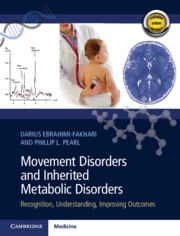Book contents
- Movement Disorders and Inherited Metabolic Disorders
- Movement Disorders and Inherited Metabolic Disorders
- Copyright page
- Dedication
- Contents
- Contributors
- Preface
- Acknowledgments
- Section I General Principles and a Phenomenology-Based Approach to Movement Disorders and Inherited Metabolic Disorders
- Section II A Metabolism-Based Approach to Movement Disorders and Inherited Metabolic Disorders
- Chapter 12 Disorders of Amino Acid Metabolism: Amino Acid Disorders, Organic Acidurias, and Urea Cycle Disorders with Movement Disorders
- Chapter 13 Disorders of Energy Metabolism: GLUT1 Deficiency Syndrome and Movement Disorders
- Chapter 14 Lysosomal Storage Disorders: Niemann–Pick Disease Type C and Movement Disorders
- Chapter 15 Lysosomal Storage Disorders: Neuronal Ceroid Lipofuscinoses and Movement Disorders
- Chapter 16 Syndromes of Neurodegeneration with Brain Iron Accumulation
- Chapter 17 Metal Storage Disorders: Inherited Disorders of Copper and Manganese Metabolism and Movement Disorders
- Chapter 18 Metal Storage Disorders: Primary Familial Brain Calcification and Movement Disorders
- Chapter 19 Disorders of Glycosylation and Movement Disorders
- Chapter 20 Disorders of Post-Translational Modifications/Degradation: Autophagy and Movement Disorders
- Chapter 21 Neurotransmitter Disorders: Disorders of Dopamine Metabolism and Movement Disorders
- Chapter 22 Neurotransmitter Disorders: DNAJC12-Deficient Hyperphenylalaninemia – An Emerging Neurotransmitter Disorder
- Chapter 23 Neurotransmitter Disorders: Disorders of GABA Metabolism and Movement Disorders
- Chapter 24 Vitamin-Responsive Disorders: Ataxia with Vitamin E Deficiency and Movement Disorders
- Chapter 25 Vitamin-Responsive Disorders: Biotin–Thiamine-Responsive Basal Ganglia Disease and Movement Disorders
- Chapter 26 Disorders of Cholesterol Metabolism: Cerebrotendinous Xanthomatosis and Movement Disorders
- Chapter 27 Purine Metabolism Defects: The Movement Disorder of Lesch–Nyhan Disease
- Chapter 28 Disorders of Creatine Metabolism: Creatine Deficiency Syndromes and Movement Disorders
- Chapter 29 Hereditary Spastic Paraplegia-Related Inborn Errors of Metabolism
- Section III Conclusions and Future Directions
- Appendix: Video Captions
- Index
- References
Chapter 19 - Disorders of Glycosylation and Movement Disorders
from Section II - A Metabolism-Based Approach to Movement Disorders and Inherited Metabolic Disorders
Published online by Cambridge University Press: 24 September 2020
- Movement Disorders and Inherited Metabolic Disorders
- Movement Disorders and Inherited Metabolic Disorders
- Copyright page
- Dedication
- Contents
- Contributors
- Preface
- Acknowledgments
- Section I General Principles and a Phenomenology-Based Approach to Movement Disorders and Inherited Metabolic Disorders
- Section II A Metabolism-Based Approach to Movement Disorders and Inherited Metabolic Disorders
- Chapter 12 Disorders of Amino Acid Metabolism: Amino Acid Disorders, Organic Acidurias, and Urea Cycle Disorders with Movement Disorders
- Chapter 13 Disorders of Energy Metabolism: GLUT1 Deficiency Syndrome and Movement Disorders
- Chapter 14 Lysosomal Storage Disorders: Niemann–Pick Disease Type C and Movement Disorders
- Chapter 15 Lysosomal Storage Disorders: Neuronal Ceroid Lipofuscinoses and Movement Disorders
- Chapter 16 Syndromes of Neurodegeneration with Brain Iron Accumulation
- Chapter 17 Metal Storage Disorders: Inherited Disorders of Copper and Manganese Metabolism and Movement Disorders
- Chapter 18 Metal Storage Disorders: Primary Familial Brain Calcification and Movement Disorders
- Chapter 19 Disorders of Glycosylation and Movement Disorders
- Chapter 20 Disorders of Post-Translational Modifications/Degradation: Autophagy and Movement Disorders
- Chapter 21 Neurotransmitter Disorders: Disorders of Dopamine Metabolism and Movement Disorders
- Chapter 22 Neurotransmitter Disorders: DNAJC12-Deficient Hyperphenylalaninemia – An Emerging Neurotransmitter Disorder
- Chapter 23 Neurotransmitter Disorders: Disorders of GABA Metabolism and Movement Disorders
- Chapter 24 Vitamin-Responsive Disorders: Ataxia with Vitamin E Deficiency and Movement Disorders
- Chapter 25 Vitamin-Responsive Disorders: Biotin–Thiamine-Responsive Basal Ganglia Disease and Movement Disorders
- Chapter 26 Disorders of Cholesterol Metabolism: Cerebrotendinous Xanthomatosis and Movement Disorders
- Chapter 27 Purine Metabolism Defects: The Movement Disorder of Lesch–Nyhan Disease
- Chapter 28 Disorders of Creatine Metabolism: Creatine Deficiency Syndromes and Movement Disorders
- Chapter 29 Hereditary Spastic Paraplegia-Related Inborn Errors of Metabolism
- Section III Conclusions and Future Directions
- Appendix: Video Captions
- Index
- References
Summary
Congenital disorders of glycosylation (CDGs) are a group of diseases characterized by an abnormal glycosylation of proteins or lipids. It is estimated that more than half of all proteins in our body are glycosylated [1]. Defined as all the sugar chains (glycans) that an organism makes, the glycome is estimated to be 102–104 times larger than the proteome [2]. Given this complexity, it is not surprising that about 2% of our genes encode for proteins that are currently known to participate in glycosylation reactions []. CDGs are classified according to the deficient glycosylated substrates, which can include proteins, lipids, or multiple substrates.
- Type
- Chapter
- Information
- Movement Disorders and Inherited Metabolic DisordersRecognition, Understanding, Improving Outcomes, pp. 254 - 269Publisher: Cambridge University PressPrint publication year: 2020



